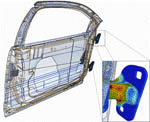
REALISTIC SIMULATION FOR CATIA USERS
Staff
General DPN Dassault Systèmes has announced the availability of ABAQUS for CATIA V5 Version 2.4 software for finite element analysis (FEA) within the PLM process. The new version introduces several advanced analysis capabilities, such as dynamic analysis, self-contact, submodeling and cyclic symmetry, expanding the functional capabilities and benefits for CATIA users. The tight integration between ABAQUS and CATIA V5 allows product design engineers and expert analysts to use the same FEA methods and models, ensuring repeatability and accuracy.
Dassault Systèmes has announced the availability of ABAQUS for CATIA V5 Version 2.4 software for finite element analysis (FEA) within the PLM process. The new version introduces several advanced analysis capabilities, such as dynamic analysis, self-contact, submodeling and cyclic symmetry, expanding the functional capabilities and benefits for CATIA users. The tight integration between ABAQUS and CATIA V5 allows product design engineers and expert analysts to use the same FEA methods and models, ensuring repeatability and accuracy.
Dynamic simulation capabilities are based on ABAQUS/Explicit. Explicit dynamic analysis is well suited for large models with relatively short response times and for modeling extremely discontinuous events, such as impact. A new capability enables the definition of very general contact conditions, including contact between many or all regions of the model with a single interaction definition.
Self-contact modeling simulates surface folding. Self-contact is typically the result of large deformation in a model, such as a complex rubber seal that folds over on itself. It is often difficult to predict which regions will be involved or how they will move relative to each other. A new capability in the software allows users to easily define self-contact for selected surfaces.
Submodeling targets regions of interest for detailed stress analysis. When analyzing large, complex models such as automotive engines or transmission housings, it is often important to focus on specific, critical areas of the model. A new submodeling tool makes it easy to obtain accurate, detailed solutions in a local region. Users are able to target a region with a refined mesh and apply submodel boundary conditions in both mechanical and thermal steps.
Cyclic symmetry modeling improves analysis efficiency and reduces model size. Cyclic symmetry modeling is useful for automotive brake disc analysis or turbomachinery simulation. When analyzing a body whose geometry, loads, prescribed conditions, and response are symmetric about an axis of revolution, users no longer need to model the entire body. With cyclic symmetry they can simply model a repeating sector of the body and set fastened pairs to define the sector boundaries. The software simulates the rest of the unmodeled body.
simulia.com
